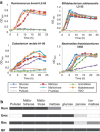Ruminococcus bromii is a keystone species for the degradation of resistant starch in the human colon
- PMID: 22343308
- PMCID: PMC3400402
- DOI: 10.1038/ismej.2012.4
Ruminococcus bromii is a keystone species for the degradation of resistant starch in the human colon
Abstract
The release of energy from particulate substrates such as dietary fiber and resistant starch (RS) in the human colon may depend on the presence of specialist primary degraders (or 'keystone species') within the microbial community. We have explored the roles of four dominant amylolytic bacteria found in the human colon in the degradation and utilization of resistant starches. Eubacterium rectale and Bacteroides thetaiotaomicron showed limited ability to utilize RS2- and RS3-resistant starches by comparison with Bifidobacterium adolescentis and Ruminococcus bromii. In co-culture, however, R. bromii proved unique in stimulating RS2 and RS3 utilization by the other three bacterial species, even in a medium that does not permit growth of R. bromii itself. Having previously demonstrated low RS3 fermentation in vivo in two individuals with undetectable populations of R. bromii-related bacteria, we show here that supplementation of mixed fecal bacteria from one of these volunteers with R. bromii, but not with the other three species, greatly enhanced the extent of RS3 fermentation in vitro. This argues strongly that R. bromii has a pivotal role in fermentation of RS3 in the human large intestine, and that variation in the occurrence of this species and its close relatives may be a primary cause of variable energy recovery from this important component of the diet. This work also indicates that R. bromii possesses an exceptional ability to colonize and degrade starch particles when compared with previously studied amylolytic bacteria from the human colon.
Figures






References
-
- Abell GCJ, Cooke CM, Bennett CN, Conlon MA, McOrist AL. Phylotypes related to Ruminococcus bromii are abundant in the large bowel of humans and increase in response to a diet high in resistant starch. FEMS Microbiol Ecol. 2008;66:505–515. - PubMed
-
- Aminov RI, Walker AW, Duncan SH, Harmsen HJM, Welling GW, Flint HJ. Molecular diversity, cultivation, and improved detection by fluorescent in situ hybridization of a dominant group of human gut bacteria related to Roseburia spp. or Eubacterium rectale. Appl Environ Microbiol. 2006;72:6371–6376. - PMC - PubMed
-
- Chassard C, Delmas E, Robert C, Lawson PA, Bernalier-Donadille A. Ruminococcus champanellensis sp.nov., a cellulose-degrading bacterium from the human gut microbiota. Int J Syst Evol Microbiol. 2011;62 (Pt 1:138–143. - PubMed
Publication types
MeSH terms
Substances
LinkOut - more resources
Full Text Sources
Other Literature Sources
Medical
Molecular Biology Databases

